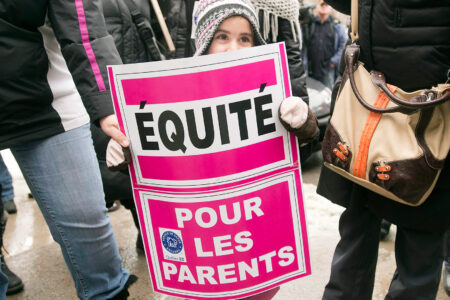
Justin Trudeau’s government has made big promises to Canadian families. In the federal budget of 2016, it declared that “high-quality, affordable child care is more than a convenience—it’s a necessity.” The government will be taking action, as the Minister of Families, Children and Social Development and the Minister of Indigenous and Northern Affairs develop agreements with provinces, territories and Indigenous communities to fulfill election commitments on child care.
It was back in 2005 that a Liberal government was last in a position to act on child care. Ken Dryden, Paul Martin’s Minister of Social Development, promised $5 billion over five years and finalized bilateral agreements with all provinces/territories. The Martin government came to the intergovernmental table with a child care policy based on four principles – quality, universality, accessibility, and developmental services (“QUAD”), but there were few implementation mechanisms in place when the new Conservative government cancelled the agreements in 2006.
Since 2006, early childhood education and care (ECEC) has evolved to some degree; for example, by September 2016, 8 of the 13 provinces/territories will offer full-day kindergarten for all five-year-olds. As well, 2001 changes to parental leave enable some parents to take year-long partly remunerated maternity/parental leave.
Nevertheless, huge gaps remain in ECEC services. While kindergarten is welcomed by parents, it serves only five-year-olds and doesn’t always match parents’ work schedules, which means it doesn’t function as child care. Fewer than half of all families are eligible for federally paid parental leave, which is paid at only 55 percent of wages or less. Child care spaces are scarce and expensive, and their quality is too often too low to be considered “developmental.”
While Canadian family policy is not very generous for most families, it is especially limited for Indigenous children. ECEC services for Indigenous children are chronically underdeveloped and underfunded. This lead the Truth and Reconciliation Commission called for culturally appropriate Indigenous early childhood education as part of healing and reconciliation.
In the 2015 election, the Liberal government committed to take action on child care as part of “supporting economic security for middle class Canadian families, and those working hard to join them.” But child care is a complex issue that is ideologically contested — there are still a few voices who protest its very existence.
Constitutionally, the provinces have the main responsibility for child care. Since the 1970s, federal governments have made several attempts to advance child care, but a comprehensive national plan has never become a reality. Each province/territory has instead developed its own policies to address ECEC, in ways that are quite similar but often less than effective. Today, no province or territory has a comprehensive plan based on the best evidence, although they all recognize that more needs to be done to support children’s development and families’ needs for care.
The OECD has noted that in all provinces/territories except for Quebec, child care funding relies too heavily on parental fees and outdated “inefficient” fee subsidies. It also states that the funding is not adequate to ensure that affordable quality services are available when and where they’re needed. The almost entirely female workforce of early childhood educators is exploited — their training, pay, and working conditions are insufficient everywhere in Canada. This compromises the quality for the children.
Finally, there is a general lack of planning. As a result, in many places there are no infant or school-age spaces; there are few services for families who work nonstandard hours, and for rural and northern families; there are too few programs designed for and by Indigenous communities; and inclusion of children with disabilities is unpredictable.
We need an overarching, cross-Canada approach
These gaps are common across Canada, though they do vary somewhat by community. Winnipeg parents can wait two years for a space, while a modest-income Toronto parent may wait two years for a fee subsidy. In Vancouver, “fully” subsidized families may need to pay an additional $500/month. For most parents across Canada there are no real options.
The federal government can help move beyond this impasse by incorporating international research, evidence and best policy practices into its policies, something the 2016 budget stressed. While it seems neither possible nor advisable to revive the 2004 Dryden-Martin plan, the federal government could steer provincial/territorial child care programs to support better work-family balance, strengthen families’ economic security, and concretely advance women’s equality.
Meeting the government’s key objectives for families in all regions will require an overarching national approach that can support a diversity of families and must engage multiple levels of government.
Supporting parents’ choices and ensuring high quality services
There are a number of key policy elements that governments should take into account as they plan the first steps of a new, effective child care system. Foremost among these are a common policy framework and long-term, stable federal financing. Both are crucial to ensure that parents’ choices are respected and services are of reliably high quality.
While families in Canada face remarkably similar child care dilemmas regardless of where they live, they are nevertheless diverse and have a variety of needs and wants. Some want regulated, full-time, part-time or part-year child care. Others prefer parental or care by a relative.
A first premise of a national child care plan should therefore be to respect parents’ choices by ensuring that real options are available. To the question, “who should get high quality child care services?” the answer should be, “any family who wants them.” Parents in minority-language and Indigenous communities, parents who work nonstandard schedules, and parents who have children with disabilities should all have reasonable, realistic choices. This means that quality services should be available when and where they are needed. If parental choice is to be a primary goal, it has to mean that a “one size fits all” program won’t do.
The policy should also ensure that services are affordable. The fee subsidy systems that provinces developed 30 years ago have failed to ensure that there is choice for low- or middle-income families. Instead, what is needed is reliable operational funding that is provided directly to services, so that parental fees are not the main revenue source. The fees for low-income families should be affordable (or, there should be no fees). The international evidence shows that operational funding is a fundamental requirement if there is to be better access and “more even” quality, mostly because it ensures that professional, qualified staff are hired, retained and supported.
Evidence also shows that children flourish in high quality child care and that poor quality may put them at risk. Key factors associated with higher quality are solid regulations, staff that are qualified in early childhood education, good child-staff ratios and group sizes, a strong pedagogical base, and adequate funding in well-resourced child care systems. Research also finds quality tends to be higher when delivered by public authorities or not-for-profit programs. Turnover is lower when staff is well educated and well paid.
The OECD has noted that low program quality is linked to “structural” (or systemic) failings. Thus, federal, provincial/territorial, and Indigenous officials should be thinking of child care in the same way they think of education and health care, treating child care as a public good in a service system based on public management and planning. Public management of child care services means solid long-term planning as well as goal-setting, targets and timetables. It means using good metrics to determine if services are high quality and meeting families’ needs. Municipal governments, school boards and not-for-profit community agencies can all contribute to managing and delivering quality child care in a public management model.
Financing child care systems
Building a child care system is not a quick project – it will take years to create the spaces and train a professional workforce in all regions of Canada. Capital expenditures will need to be made and services will need ongoing operational support.
Provinces/territories need to be confident they can afford the programs to which they commit. Ottawa must be a partner that other jurisdictions can count on over the long-haul, so there is no repeat of the abrupt cancellation of the bilateral agreements that occurred in 2006.
The international benchmark for ECEC spending is that nations should spend at least 1 per cent of their GDP on ECE, but Canada spends only about one-third of this on kindergarten and child care together. According to the OECD and UNICEF, among wealthy countries, Canada spends the least on child care.
The Trudeau government’s multi-purpose Social Infrastructure Fund, pegged at $20 billion over 10 years, will be a start in the financing of a child care system. The share of these funds allocated to child care (none in 2016 and $500 million planned for 2017) is sufficient to take the very first steps towards the envisioned child care system.
In the medium term, however, the government needs to consider additional funds for provincial/territorial and Indigenous capital costs, operating costs, and child-care-system management costs.
Parental choice, high quality and system financing are key elements of the national plan that the federal government should be championing. Working together, the federal government, provinces/territories and Indigenous communities can use these three elements as a basis for designing a common, detailed, evidence-based policy framework.
Mechanisms and implementation
All levels of government will need to collaborate using the best available evidence of what works in designing the national plan. The federal government will transfer its dollars so provinces/territories and Indigenous communities can develop their child care systems. Federal dollars should be earmarked for building/renovating, stable operational funding, and supporting and developing the system. The provinces/territories and Indigenous communities will need to develop multiyear plans for spending the funds in ways that make the best sense for them within the overarching framework.
Good planning will be crucial. As the evidence shows, the best way to ensure that parents have choices to good quality services is public management. Markets chase dollars — they don’t plan. Markets give us the phenomenon of a neighbourhood with multiple sushi restaurants or frozen yoghurt shops – maybe nice for diners but an unreliable way to ensure that crucially needed services are available. Planning ensures that quality services are available where parents want and need them.
The Liberals campaigned on a promise to support the middle class. Today’s middle-class families need a child care system that works for everybody. By moving beyond baby steps to planning a national child care system, the Trudeau government can help lead the development of a child care system that works for all of us.
Photo: ChiccoDodiFC/Shutterstock.com
Do you have something to say about the article you just read? Be part of the Policy Options discussion, and send in your own submission. Here is a link on how to do it. | Souhaitez-vous réagir à cet article ? Joignez-vous aux débats d’Options politiques et soumettez-nous votre texte en suivant ces directives.










